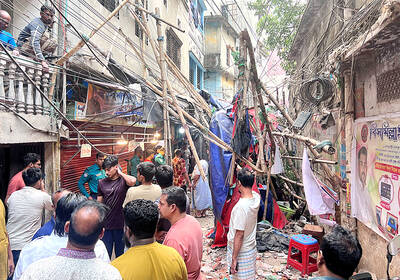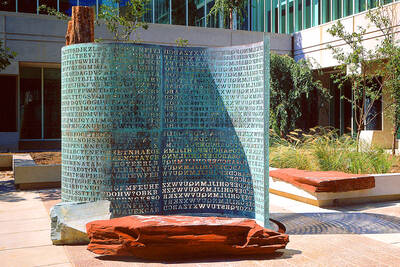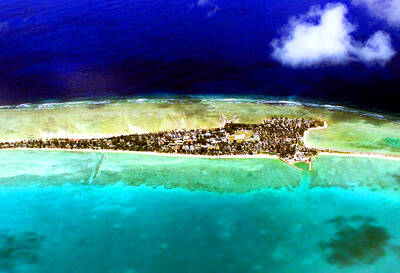A year after Colombian military agents disguised as international aid workers helicoptered Ingrid Betancourt and three US military contractors to freedom, an offer by their former leftist rebel captors to unilaterally free two hostages is in limbo.
Many blame Colombian President Alvaro Uribe, who says “drop by drop” releases by the rebels end up being publicity stunts for “terrorists” that complicate military efforts to end the the country’s decades-long conflict once and for all.
As Colombia celebrates the daring Betancourt rescue of July 2 last year, the joy is not shared by the family of Corporal Pablo Emilio Moncayo, a soldier captured by the rebels more than 11 years ago in an attack on a remote mountain outpost.
The Revolutionary Armed Forces of Colombia, or FARC, said in mid-April it intended to free Moncayo. On Monday, it said it would release a second soldier with him.
But Uribe refused the FARC’s demand that Senator Piedad Cordoba, a close ally of Venezuelan President Hugo Chavez, be present for any hostage handover. She has attended five previous unilateral releases of a total of 12 hostages since early last year.
“The president has to make this decision,” Cordoba said on Tuesday, telling reporters she was not publicly pressing Uribe because it “only makes him more uncomfortable.”
One of the last unconditional handovers by the FARC, in early February, was marred by military flyovers that peace activists who accompanied Cordoba termed harassment.
The government complained about Cordoba inviting a journalist along.
She alone accompanied the International Red Cross and a Brazilian helicopter crew on the next two handovers.
The FARC is wary of any hostage release that excludes Cordoba. In the rescue of Betancourt, the Americans and 11 others, one of the Colombian agents wore a Red Cross bib, violating international law.
The ruse consisted of tricking the hostages’ jailers — who are now themselves in jail — into believing an international humanitarian group was transferring them to a different FARC camp.
Uribe says he would only accept the International Red Cross and the Roman Catholic Church as intermediaries.
“We don’t understand why exactly President Uribe doesn’t respect the life of Pablo Emilio,” said 22-year-old Yuri Tatiana Moncayo, one of the captive corporal’s four sisters.
Uribe has condemned previous releases as “political shows” meant to boost the image of the FARC, which killed his father in a botched 1983 kidnapping and whose defeat has been the cornerstone of his seven-year-old presidency.
“The president isn’t going to facilitate any unilateral liberation because he thinks that will boost the FARC’s political agenda and hurt the government,” political analyst Claudia Lopez said.
“It’s cruel, but that’s the way it is,” Lopez said.
The chief of Colombia’s armed forces, General Freddy Padilla, underlined that view on Wednesday, criticizing the rebels’ handling of hostage releases.
“They want to convert each hostage release into a prolonged two-month drama and this masks the true intentions and conduct of this criminal insurgency,” Padilla said in an interview.

DISASTER: The Bangladesh Meteorological Department recorded a magnitude 5.7 and tremors reached as far as Kolkata, India, more than 300km away from the epicenter A powerful earthquake struck Bangladesh yesterday outside the crowded capital, Dhaka, killing at least five people and injuring about a hundred, the government said. The magnitude 5.5 quake struck at 10:38am near Narsingdi, Bangladesh, about 33km from Dhaka, the US Geological Survey (USGS) said. The earthquake sparked fear and chaos with many in the Muslim-majority nation of 170 million people at home on their day off. AFP reporters in Dhaka said they saw people weeping in the streets while others appeared shocked. Bangladesh Interim Leader Muhammad Yunus expressed his “deep shock and sorrow over the news of casualties in various districts.” At least five people,

ON THE LAM: The Brazilian Supreme Court said that the former president tried to burn his ankle monitor off as part of an attempt to orchestrate his escape from Brazil Former Brazilian president Jair Bolsonaro — under house arrest while he appeals a conviction for a foiled coup attempt — was taken into custody on Saturday after the Brazilian Supreme Court deemed him a high flight risk. The court said the far-right firebrand — who was sentenced to 27 years in prison over a scheme to stop Brazilian President Luiz Inacio Lula da Silva from taking office after the 2022 elections — had attempted to disable his ankle monitor to flee. Supreme Court judge Alexandre de Moraes said Bolsonaro’s detention was a preventive measure as final appeals play out. In a video made

It is one of the world’s most famous unsolved codes whose answer could sell for a fortune — but two US friends say they have already found the secret hidden by Kryptos. The S-shaped copper sculpture has baffled cryptography enthusiasts since its 1990 installation on the grounds of the CIA headquarters in Virginia, with three of its four messages deciphered so far. Yet K4, the final passage, has kept codebreakers scratching their heads. Sculptor Jim Sanborn, 80, has been so overwhelmed by guesses that he started charging US$50 for each response. Sanborn in August announced he would auction the 97-character solution to K4

SHOW OF FORCE: The US has held nine multilateral drills near Guam in the past four months, which Australia said was important to deter coercion in the region Five Chinese research vessels, including ships used for space and missile tracking and underwater mapping, were active in the northwest Pacific last month, as the US stepped up military exercises, data compiled by a Guam-based group shows. Rapid militarization in the northern Pacific gets insufficient attention, the Pacific Center for Island Security said, adding that it makes island populations a potential target in any great-power conflict. “If you look at the number of US and bilateral and multilateral exercises, there is a lot of activity,” Leland Bettis, the director of the group that seeks to flag regional security risks, said in an